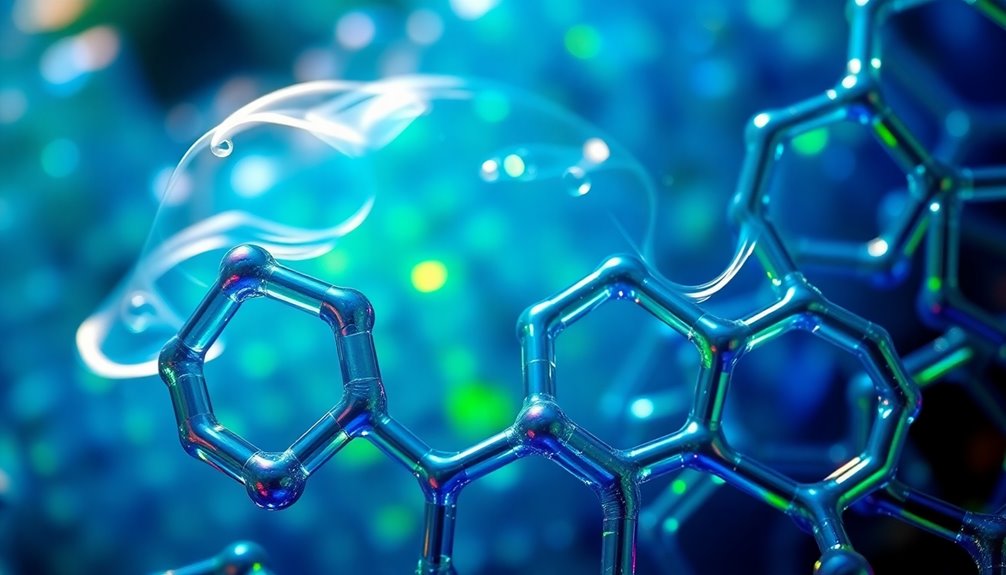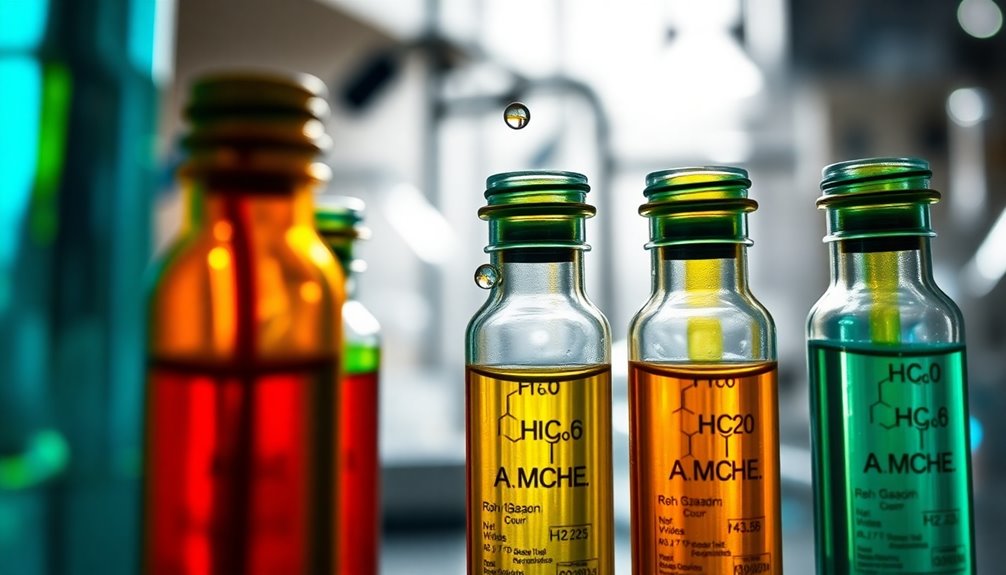To identify which molecules are aromatic hydrocarbons, you'll want to look for those with a cyclic structure and delocalized π electrons, following Huckel's rule (4n + 2). Common examples include benzene, toluene, and naphthalene. Each of these compounds features a planar arrangement of sp² hybridized carbon atoms that allow for effective p-orbital overlap. While certain molecules may appear cyclic, they might not be aromatic if they lack electron delocalization. Understanding these criteria will help clarify aromaticity. Stay curious, as there's much more to discover about these fascinating compounds and their significance in chemistry!
Key Takeaways
- Aromatic hydrocarbons must have a cyclic structure with delocalized π electrons according to Huckel's rule.
- Each carbon atom in an aromatic ring is sp² hybridized, enabling effective p-orbital overlap.
- Common examples include benzene, toluene, naphthalene, and compounds with heteroatoms like pyridine.
- Non-aromatic compounds lack sufficient electron delocalization or a cyclic structure, disqualifying them.
- Misconceptions about aromaticity often confuse classification; only compounds meeting all criteria are truly aromatic.
Definition of Aromatic Hydrocarbons

Aromatic hydrocarbons, often called arenes, are intriguing compounds that have a distinct cyclic structure and feature delocalized π electrons.
These aromatic compounds must adhere to Huckel's rule, which specifies that they contain (4n + 2) π electrons, where n is a non-negative integer. Each carbon atom in the benzene ring is sp² hybridized, allowing for continuous overlap of p-orbitals and providing resonance stability.
This unique arrangement is what gives aromatic hydrocarbons their special chemical properties. Common examples include benzene, toluene, and naphthalene.
Unlike their aromatic counterparts, non-aromatic compounds fail to have the required cyclic structure or sufficient electron delocalization, clearly distinguishing them from true aromatic hydrocarbons.
This structure and electron configuration define their aromatic nature.
Criteria for Aromaticity
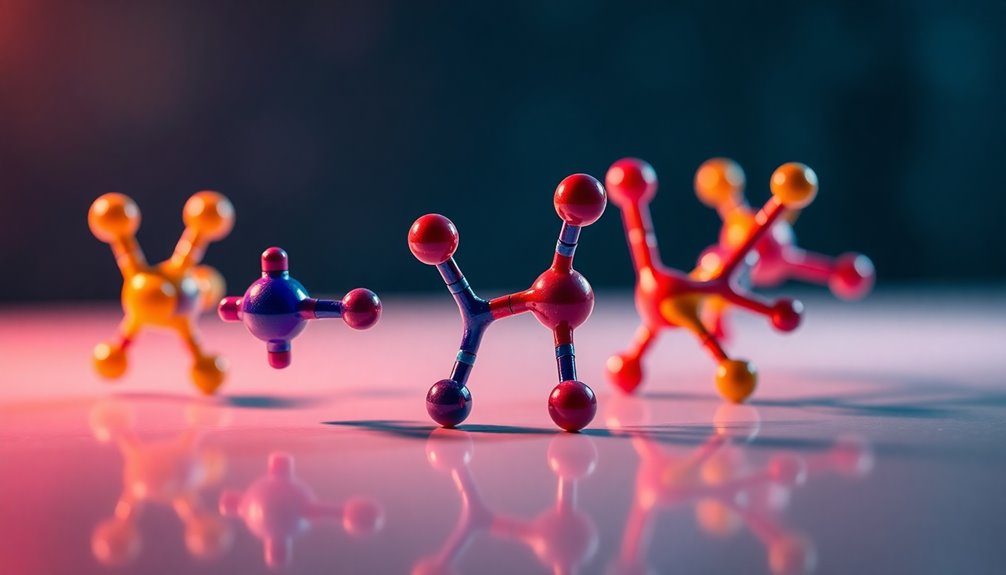
To determine if a hydrocarbon is aromatic, it must meet several specific criteria.
First, it needs a cyclic structure that allows for a planar arrangement, ensuring effective overlap of p-orbitals for electron delocalization.
Every atom in the aromatic ring should be sp² hybridized, creating a continuous π-electron system.
Additionally, it must adhere to Huckel's rule, which states that the compound needs (4n + 2) π electrons, where n is a non-negative integer.
Remember, the presence of substituents on the ring doesn't negate aromaticity as long as these fundamental criteria are satisfied.
If a compound lacks cyclic planarity or the necessary electron delocalization, it fails to be classified as aromatic.
Common Examples of Aromatic Compounds
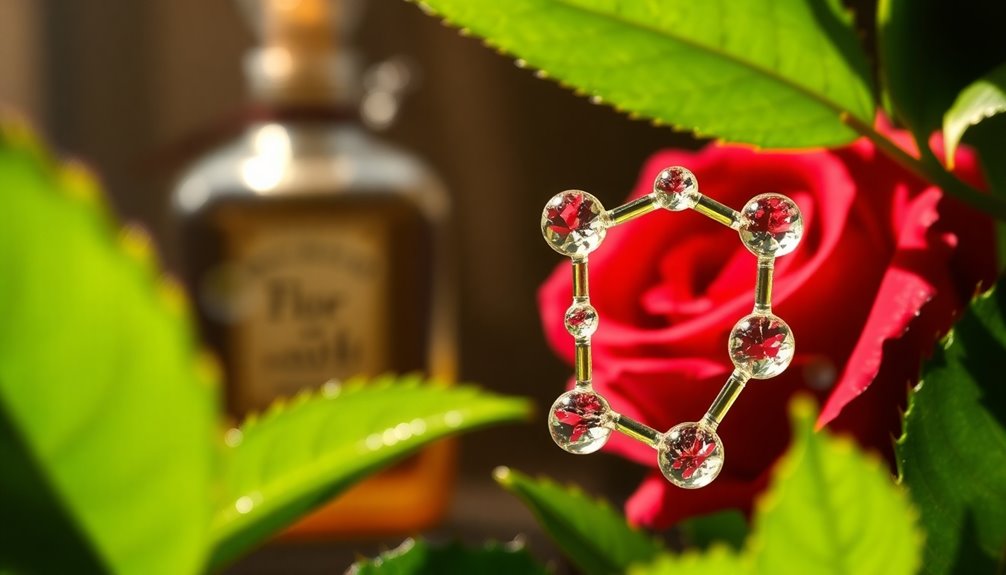
When you think about aromatic compounds, benzene, toluene, and naphthalene likely come to mind. Each of these has a unique cyclic structure with delocalized π electrons, giving them their aromatic properties.
You'll also find other interesting examples, like pyridine and furan, which introduce heteroatoms into the mix.
Common Aromatic Examples
While exploring the world of aromatic compounds, you'll encounter several common examples that highlight their unique structures and properties.
Aromatic hydrocarbons like benzene, toluene, and naphthalene showcase the fascinating characteristics of these compounds. Benzene, the simplest aromatic hydrocarbon, consists of six carbon atoms in a planar ring, adhering to Huckel's rule with its six π electrons.
Toluene, derived from benzene, features a methyl group attached to the ring, preserving its aromatic nature.
Naphthalene, a classic example of polycyclic aromatic hydrocarbons (PAHs), comprises two fused benzene rings, commonly found in mothballs.
These compounds illustrate the stability and distinct traits of aromatic hydrocarbons, making them essential in various applications and everyday products.
Identifying Aromatic Structures
How can you easily identify aromatic structures among various compounds?
Start by looking for aromatic hydrocarbons that feature a planar structure with sp² hybridized carbon atoms. This arrangement allows for continuous overlapping p-orbitals, essential for electron delocalization.
To confirm aromaticity, apply Huckel's rule: the compound must have (4n + 2) π electrons, where n is a non-negative integer. Common examples include benzene, toluene, and naphthalene, all of which contain aromatic rings meeting these criteria.
Don't overlook compounds like pyridine and pyrrole; they also exhibit aromatic properties despite having heteroatoms.
Be cautious with non-aromatic compounds, such as cyclohexane, as they lack the necessary cyclic structure or electron delocalization to be classified as aromatic.
Identifying Aromatic Molecules
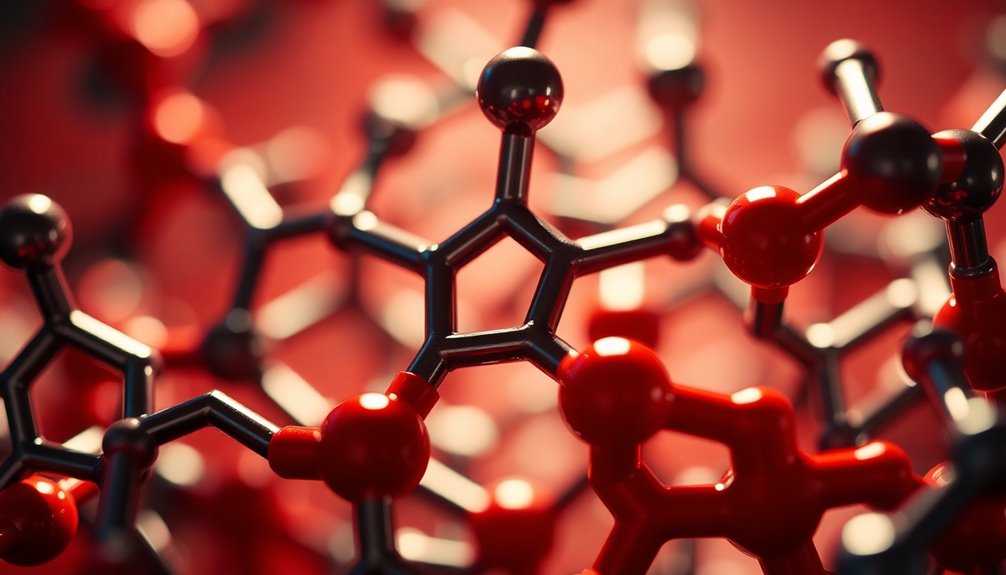
What makes a hydrocarbon aromatic? To identify aromatic hydrocarbons, you should look for a planar aromatic ring where all carbon atoms are sp² hybridized. This sp² hybridization enables the necessary overlap of p-orbitals, facilitating electron delocalization.
An aromatic compound must also adhere to Huckel's rule, meaning it contains (4n + 2) π electrons, ensuring stability through resonance. While substituents on the aromatic ring can affect aromaticity, they don't negate it.
Applications of Aromatic Hydrocarbons

Aromatic hydrocarbons play an important role in various industries, serving as key ingredients in everything from pharmaceuticals to dyes.
However, it's vital to take into account the health and safety impacts associated with their use.
Understanding these applications and their implications will help you appreciate the balance between functionality and safety in industrial practices.
Industrial Uses Overview
While you may not realize it, aromatic hydrocarbons play an essential role in various industrial applications that touch your everyday life. These compounds are vital in the production of numerous products, enhancing both functionality and appeal.
Here are some key uses:
- Serve as solvents in paint thinners and coatings.
- Act as intermediates in pharmaceuticals, boosting drug efficacy.
- Synthesize polymers like polystyrene and polycarbonate for consumer goods.
Additionally, aromatic hydrocarbons are pivotal in the fragrance industry, contributing to the scents of perfumes and food additives.
They also provide vibrant colors in dyes and pigments for textiles and inks. Their versatility makes aromatic hydrocarbons an integral part of modern manufacturing and product development.
Health and Safety Impacts
The health and safety impacts of aromatic hydrocarbons are significant, especially in industrial settings. Compounds like benzene and toluene are known carcinogens, leading to severe health effects, including blood disorders and leukemia from prolonged exposure.
You can encounter these harmful substances through inhalation, skin contact, or ingestion, making stringent safety protocols essential. Regulatory agencies, such as the US EPA, set exposure limits to safeguard public health and minimize environmental impacts.
The persistence and potential bioaccumulation of these hydrocarbons raise concerns about long-term ecological and human health issues. Public health initiatives work to reduce exposure through awareness campaigns and stringent regulations on emissions from industrial processes and vehicle exhaust.
It's vital to stay informed and prioritize safety in environments where these compounds are present.
Health and Environmental Concerns

Due to their toxic and carcinogenic properties, many aromatic hydrocarbons pose serious health and environmental risks that can't be ignored. Exposure to these compounds can lead to significant health concerns, including blood disorders and cancer risks.
Their environmental persistence means they contribute to air pollution, affecting both human health and ecosystems.
- Benzene exposure is linked to hematotoxicity and leukemia.
- Regulatory agencies monitor emissions to prevent respiratory harm.
- Public health initiatives aim to reduce exposure and promote safety.
Addressing these issues is essential for protecting public health and the environment.
Misconceptions About Aromaticity

Aromaticity often gets misunderstood, leading to confusion about which compounds truly belong to this unique class. Not every cyclic compound is aromatic; for example, cyclohexane lacks delocalized electrons and doesn't meet Huckel's rule. Furthermore, the presence of double bonds alone doesn't guarantee aromaticity. Some compounds may have alternating single and double bonds but still fail to achieve the required planarity. Anti-aromatic compounds, with (4n) π electrons, are unstable and lack resonance stability. Polycyclic aromatic hydrocarbons (PAHs) are classified as aromatic due to Huckel's criteria, regardless of how many rings they possess.
| Misconception | Truth |
|---|---|
| All cyclic compounds are aromatic | Only those with delocalized electrons are |
| Double bonds guarantee aromaticity | Planarity and electron delocalization matter |
| PAHs are aromatic due to ring count | They must meet Huckel's rule |
Future Directions in Aromatic Chemistry
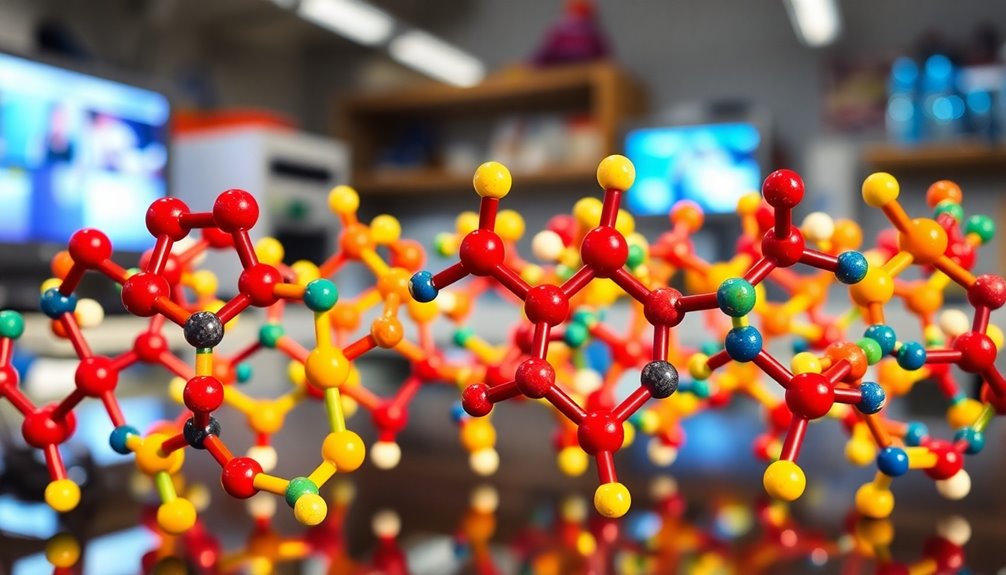
As researchers explore the future of aromatic chemistry, they're prioritizing greener synthesis methods that minimize toxicity and environmental impact. This shift towards green chemistry is essential for sustainable development.
By focusing on innovative catalytic processes, they're enhancing the efficiency of aromatic hydrocarbon production.
- Exploring biobased aromatic compounds derived from renewable resources
- Investigating the applications of aromatic compounds in nanotechnology
- Understanding metabolic pathways for the biodegradation of aromatic hydrocarbons
These efforts not only provide alternatives to petroleum-based products but also highlight the versatility of aromatic compounds in emerging technologies.
As you follow these advancements, you'll see how they contribute to effective bioremediation strategies and a more sustainable future in chemistry.
Frequently Asked Questions
How Do Aromatic Hydrocarbons Differ From Aliphatic Hydrocarbons?
Aromatic hydrocarbons are different from aliphatic hydrocarbons mainly in their structure and stability.
You'll notice that aromatic compounds have a closed ring with alternating double bonds, creating a stable electron cloud above and below the ring.
In contrast, aliphatic hydrocarbons consist of straight or branched chains of carbon atoms without this ring structure.
This difference influences their chemical properties and reactions, making aromatic hydrocarbons often more stable and less reactive than aliphatic ones.
What Role Do Aromatic Hydrocarbons Play in Everyday Products?
They say, "you can't judge a book by its cover," and that holds true for aromatic hydrocarbons.
These compounds play crucial roles in everyday products, from fragrances and dyes to plastics and fuels. You might find them in your favorite perfume or the inks you use.
Their unique structures contribute to stability and reactivity, making them essential in creating many materials you encounter daily, enhancing both functionality and aesthetic appeal.
Are All Benzene Derivatives Considered Aromatic Hydrocarbons?
Not all benzene derivatives are considered aromatic hydrocarbons.
For a compound to be classified as aromatic, it must meet specific criteria, including having a planar structure, being cyclic, and following Huckel's rule of 4n + 2 π electrons.
Some benzene derivatives might lack these characteristics due to substitutions or structural changes.
Can Aromatic Hydrocarbons Be Synthesized Artificially?
Yes, you can synthesize aromatic hydrocarbons artificially through various chemical reactions.
For instance, you might use processes like Friedel-Crafts alkylation or acylation to create benzene derivatives. Additionally, coupling reactions can help you form larger aromatic structures.
These methods allow you to manipulate the molecular framework, tailoring the properties of the compounds you create.
What Are the Common Sources of Exposure to Aromatic Hydrocarbons?
You can encounter aromatic hydrocarbons in various everyday situations.
Common sources include vehicle exhaust, tobacco smoke, and industrial emissions. If you work in certain industries, like petrochemicals or manufacturing, you might be exposed during production processes.
Household products, like paints, solvents, and cleaners, often contain these compounds too.
It's crucial to be aware of these sources to minimize your exposure and protect your health.
Conclusion
To sum up, aromatic hydrocarbons are the dazzling gems of the chemical world, capturing our fascination with their unique structures and properties. Their delightful scents and versatile applications make them essential in countless industries, from perfumes to pharmaceuticals. However, don't let their charm overshadow the lurking health and environmental risks they pose. As you explore these enchanting compounds, remember to tread carefully—your health and the planet depend on it. Embrace the wonders of aromatic chemistry, but stay vigilant!

